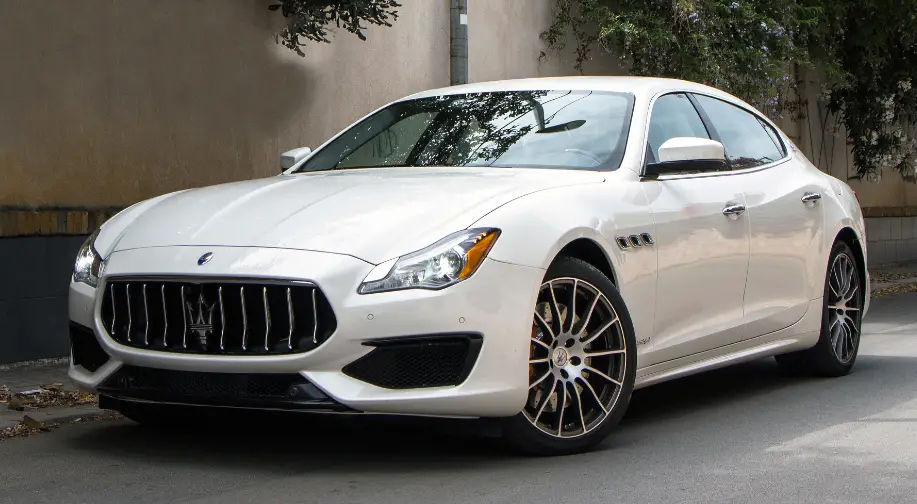
2017 Maserati Quattroporte Owner’s Manual
The 2017 Maserati Quattroporte is a flagship sedan that combines Italian luxury and speed. This four-door beauty is both elegant and exciting. It has an eye-catching design, a range of powerful V6 and V8 engines, and a luxuriously appointed interior. The Quattroporte is a symbol of Maserati’s long history and a sign of respect in the world of luxury cars because it combines dynamic driving and high-quality craftsmanship in a way that works well together.
Driving
Normal Starting of the Engine
WARNING: It is dangerous to run the engine in an enclosed area. The engine consumes oxygen and discharges carbon dioxide, carbon monoxide, and other toxic gases into the atmosphere.
When doors are opened, the instrument cluster displays the Maserati Logo in the center and the complete odometer plus the open doors indicator in the lower part of the cluster. Before starting the engine, close the doors, adjust your seat, and the inside and outside mirrors, fasten your seat belt, and instruct all other occupants to buckle their seat belts.
The shift lever must be in the P (Park) or N (Neutral) position before you can start the engine. Apply the brakes before shifting into any driving gear (see “Automatic Transmission” in this section).
CAUTION
- Before starting the engine, switch off the electrical devices with a high power consumption (air-conditioning and heating system, heated rear window, headlights, etc.).
- Do not start the engine if the fuel level in the tank is low.
The keyless ignition allows the driver to operate the ignition switch by pushing the center button, as long as the key fob RKE transmitter is within the passenger compartment (check “Keys” in the section “Before Starting” for further information). By pressing the brake pedal and pushing the START/STOP button the engine starts. The instrument panel displays the initial sequence with a warning light and analog instruments test routine and switch-on of the engine temperature indicators and fuel level. This happens if the option “On” is set in screen settings for display switch-on (see chapter “Instrument cluster” in section “Dashboard Instruments and Controls”). The current display is subsequently set up with the latest screenshot. If the engine fails to start, the starter will disengage automatically after 10 seconds. If you wish to stop the cranking of the engine prior to starting it, press the button again.
NOTE: Normal starting of either a cold or a warm engine is obtained without pumping or pressing the accelerator pedal.
If the driver only pushes the START/STOP button but does not press the brake pedal, the ignition switch cycles to the ACC position (see “Keys” in section “Before Starting”) and the instrument cluster displays the latest screenshot. At the second press of the START/STOP button, the ignition device switches to the RUN position (see “Keys” in the section “Before Starting”) and the instrument cluster displays the latest screenshot. At the third press of the START/STOP button the ignition switch returns to the OFF position and the display powers down. At the fourth press of the START/STOP button, the screen will display the message that invites you to press the brake pedal and push the START/STOP button to start the engine.
NOTE: If the ignition switch is left in the ACC or RUN (engine not running) position and the transmission is in P (Park), the system will automatically time out after 30 minutes of inactivity and the ignition will switch to the OFF position.
After starting the engine, the idle speed is controlled automatically and will decrease as the engine warms up.
Notes for the Diesel Engine Starting (Diesel only)
With cold engine and external temperature below 0°C, ignition may be delayed a few seconds in order to allow the spark plugs to pre-heat. In this case the amber light will illuminate on the TFT display and will stay on for a few seconds after the engine has started.
Cold Weather Precautions (Diesel only)
If the outside temperature is very low, the diesel fuel thickens due to the formation of paraffin clots and could clog the diesel filter. In order to avoid these problems, different types of diesel fuel are distributed according to the season: summer type, winter type, and arctic type (very cold, mountainous areas). If refueling with diesel fuel whose specifications are not suitable for the too-cold outside temperature, it is advisable to mix TUTELA DIESEL ART additive in the proportions shown on the container with the fuel. Pour the additive into the tank before the fuel using the funnel provided.
Engine Start Failure
CAUTION
- Do not attempt to push or tow your vehicle to get it started. Vehicles equipped with an automatic transmission cannot be started this way. Moreover, unburned fuel could enter the catalytic converter and once the engine has started, ignite and damage the converter and vehicle.
- If the vehicle has a discharged battery, booster cables may be used to obtain a start from a booster battery or the battery in another vehicle. This type of start can be dangerous if done improperly. See “Auxiliary Jump Start Procedure” in the section “In an Emergency” for further information.
Flooded engine clearing
If the engine fails to start after you have followed the described procedures, it may be flooded. To clear any excess fuel, move the shift lever in the P (Park) position. Press and hold the brake pedal, push the accelerator all the way to the floor, and hold it, then press and release the START/STOP button once. The starter will engage automatically, run for 10 seconds, and then disengage. Once this occurs, release the accelerator pedal and the brake pedal, wait 10 to 15 seconds, then repeat the “Normal starting of the engine” procedure.
Starting by cold engine Start-off slowly, avoiding sudden acceleration, and rev the engine up at low and medium speeds. High-performance driving should be avoided until the engine temperature reaches 65-70°C (149-158°F).
Engine Turn Off
- Place the shift lever in P (Park) (see “Automatic Transmission” in this section).
- With the engine at idle, press and release the START/STOP button. The ignition switch will return to the OFF position. A burst on the accelerator pedal before turning off the engine has no purpose and increases fuel consumption.
- If the shift lever is not in P (Park), the START/STOP button must be held for two seconds and vehicle speed must be above 8 km/h (5 mph) before the engine will shut off. The ignition switch will remain in the ACC position until the shift lever is in the P (Park) and the button is pressed twice from the OFF position.
- If the shift lever is not in P (Park) and the START/STOP button is pressed once, the instrument cluster will display a “Vehicle Not in Park” message, and the engine will remain running.
WARNING: Never leave a vehicle out of the P (Park) position, as it could move.
NOTE: If the ignition switch is left in the ACC or RUN (engine not running) position and the transmission is in P (Park), the system will automatically time out after 30 minutes of inactivity and the ignition will switch to the OFF position.
“Panic Stop” Strategy
In panic conditions, if the driver stops the engine in any non-standard manner while driving at a speed over 3 km/h (2 mph), the “Panic Stop” strategy can manage the situation by checking the gearchange condition upon engine cutting, driver’s action on brakes, road condition (flat or slope) so as to set gearchange to the most suitable condition. The “Panic Stop” strategy considers that the driver should stop the engine by pressing the ignition switch at least 3 times or holding it depressed for at least 5 seconds.
Automatic Start&Stop System
The Maserati Start&Stop system allows the engine to automatically switch off when the vehicle stops and to restart when the driver intends to drive. This feature can reduce fuel consumption by up to 6% according to different drive conditions. During the “Stop
(AutoStop)” phase the ignition is still on and all security features are available.
In order for the Start&Stop to activate, the vehicle must be stationary and the brake pedal adequately pressed.
NOTE: If the brake pedal is not sufficiently pressed the Start&Stop may not function even if the vehicle is stopped.
When the Start&Stop switches off the engine, the related light illuminates on the instrument cluster. As soon as the brake pedal is released, the engine turns on. While the vehicle is stopped, the shift lever can be placed in P (Park). In this case, it is possible to release the brake pedal and the vehicle will remain in “AutoStop” with the engine off. Pressing the brake pedal and shifting gear into D (Drive) or R (Reverse) will deactivate the “AutoStop” condition and restart the engine.
FAQ’s
A: The 2017 Maserati Quattroporte offered a choice of powerful engines, including a 3.0-liter V6 and a 3.8-liter V8.
A: The V6 engine in the 2017 Quattroporte generated 404 horsepower.
A: The 2017 Quattroporte featured an elegant and aerodynamic exterior design with Maserati’s signature Trident grille and sleek lines.
A: Yes, the 2017 Quattroporte was available with Maserati’s Q4 all-wheel-drive system.
A: The Quattroporte came with an 8-speed automatic transmission.
A: The top speed of the 2017 Quattroporte varied depending on the engine choice but could exceed 170 mph (273 km/h).
A: The Quattroporte could comfortably seat up to five passengers.
A: The 2017 Quattroporte offered a luxurious interior with features such as premium leather upholstery, wood trim, an infotainment system, and a premium sound system.
A: Fuel efficiency varied depending on the engine choice, but it typically ranged from 15 to 19 mpg in the city and 21 to 28 mpg on the highway.
A: The 2017 Quattroporte included a range of safety features, such as adaptive cruise control, blind-spot monitoring, lane departure warning, and forward collision warning.
A: Yes, the 2017 Quattroporte was available in various trim levels, including the base, S, S Q4, GTS, and GranLusso.
A: Yes, it featured an infotainment system with navigation, smartphone integration, and optional premium audio systems.
A: The starting price for the 2017 Quattroporte varied based on the trim level and options but typically started at around $100,000.
A: The 2017 Quattroporte delivered a dynamic driving experience with powerful engines, precise handling, and a comfortable ride, embodying the essence of a luxury sports sedan.
A: The 2017 Quattroporte distinguished itself with its Italian design, robust engine options, and a perfect balance between performance and luxury, making it a unique choice in the competitive luxury sedan market.
Useful Links
Maserati Ghibli 2021 User Manual
Maserati Levante 2021 User Manual

